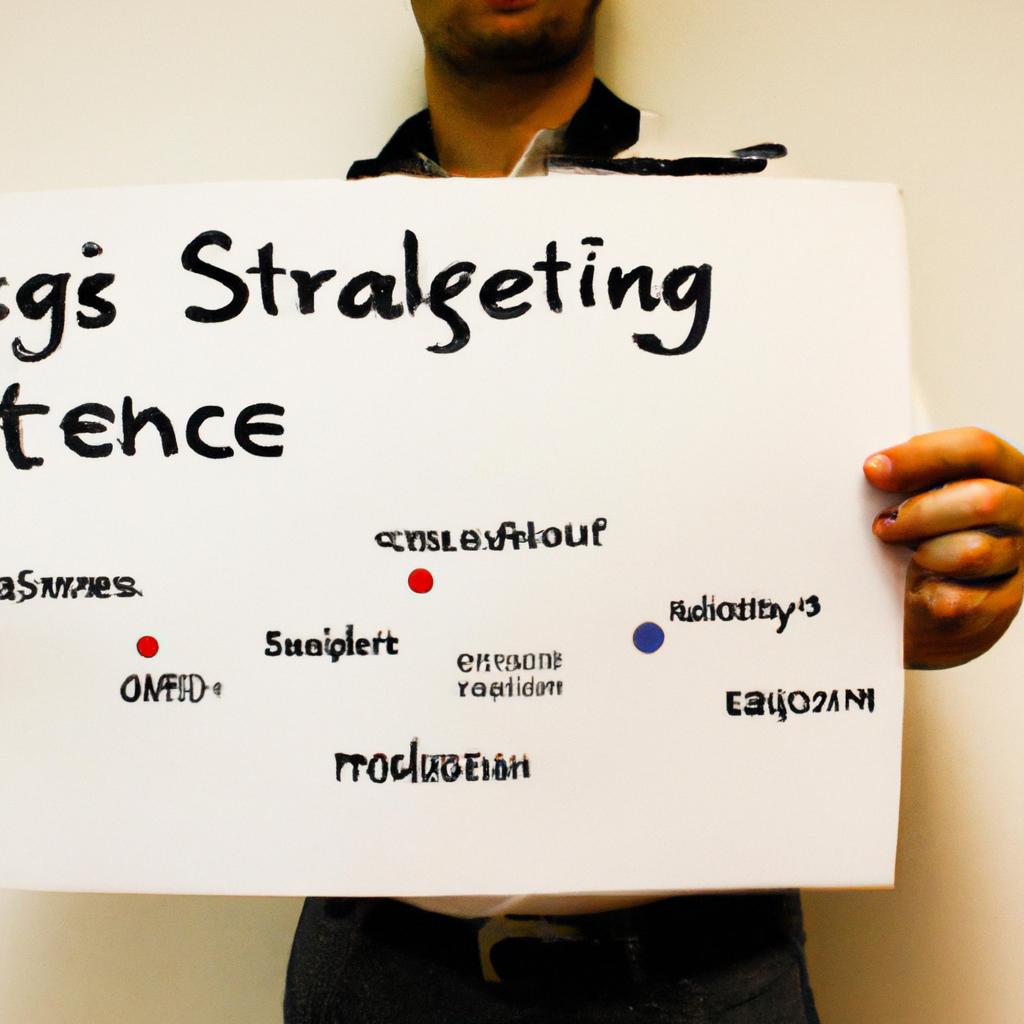In the competitive world of marketing and advertising, promotional strategies play a crucial role in determining the success of a campaign. These strategies encompass various techniques used to communicate with target audiences, create brand awareness, and ultimately drive sales. For instance, imagine a hypothetical scenario where a new tech company is launching its latest product—a state-of-the-art smartphone. In order to maximize the reach and impact of their campaign, they implement a combination of traditional and digital promotional strategies such as television commercials, social media advertisements, influencer partnerships, and interactive online experiences.
The effectiveness of promotional strategies lies not only in their ability to capture attention but also in their capacity to engage consumers on multiple platforms. With the ever-increasing prevalence of technology in our daily lives, companies need to adapt their promotional efforts accordingly. This entails utilizing both traditional channels like print media and television advertisements alongside newer avenues such as social media marketing and search engine optimization (SEO). By integrating these diverse approaches into a cohesive campaign strategy, businesses can ensure that their message reaches the right audience at the right time through the most effective means possible. However, it is important for marketers to remember that successful promotion goes beyond simply getting noticed; it requires creating meaningful connections with consumers by delivering relevant content that resonates with their needs and desires.
To achieve this, marketers must conduct thorough research and analysis to understand their target audience’s demographics, interests, and behavior patterns. With this knowledge in hand, they can tailor their promotional content to align with consumers’ preferences and expectations. This could involve creating compelling storytelling through advertisements that evoke emotions or showcasing the product’s unique features and benefits in a relatable manner.
Moreover, in today’s digital age, it is essential for businesses to leverage social media platforms effectively. By engaging with consumers through interactive posts, responding to comments and messages promptly, and running targeted ad campaigns on platforms like Facebook or Instagram, companies can build brand loyalty and foster ongoing relationships with their customers.
Another effective promotional strategy is partnering with relevant influencers or industry experts who have a strong online presence. These influencers can help amplify the brand message by promoting the product to their large following. Their endorsement adds credibility and trustworthiness to the campaign, increasing the likelihood of consumer engagement.
Furthermore, interactive online experiences such as virtual reality (VR) or augmented reality (AR) can enhance consumer engagement by providing immersive experiences related to the product. For example, allowing potential customers to virtually try out the smartphone’s features or explore its design through an AR app can generate excitement and increase the likelihood of purchase.
In conclusion, successful promotional strategies go beyond mere attention-grabbing techniques; they aim to establish meaningful connections with consumers by delivering relevant content through various channels. By utilizing both traditional and digital marketing avenues while tailoring messaging based on consumer insights, businesses can maximize their reach and impact in today’s competitive landscape.
TV Advertising: Reaching a wide audience through impactful visual storytelling.
TV advertising is a powerful tool that allows businesses to reach a wide audience through impactful visual storytelling. By utilizing the extensive reach of television networks, companies can effectively communicate their message and create brand awareness on a large scale.
One example of successful TV advertising is the case study of Coca-Cola’s “Share a Coke” campaign. In this campaign, Coca-Cola replaced its logo with popular names, encouraging people to find bottles with their own name or the names of loved ones. This personalized approach not only sparked curiosity but also created an emotional connection with consumers. The use of TV commercials played a crucial role in spreading the message nationwide and engaging a diverse range of viewers.
To further illustrate the effectiveness of TV advertising, let us consider some key advantages it offers:
- Wide Reach: Television has long been one of the most dominant forms of media consumption worldwide. With numerous channels available across different genres and demographics, businesses have access to a vast pool of potential customers.
- Impactful Visuals: TV advertisements allow for creative storytelling through visuals and audio elements. This combination has proven to be highly effective in capturing viewers’ attention and conveying messages in a memorable way.
- Emotional Appeal: Through compelling narratives and visually appealing content, TV ads have the ability to evoke emotions within viewers. Whether it’s humor, nostalgia, or inspiration, these emotional connections can significantly influence consumer behavior.
- Trustworthy Medium: Television has established itself as a trusted source of information and entertainment over many years. As such, advertisements presented on this platform often benefit from the credibility associated with television programming.
In summary, TV advertising enables businesses to engage with audiences on a mass scale by utilizing impactful visual storytelling techniques. Its wide reach, ability to evoke emotions, and association with trust make it an essential promotional strategy for maximizing campaign success.
Moving forward into our next section about “Social Media Campaigns,” we will explore how businesses can engage target customers through interactive and shareable content without missing a beat.
Social Media Campaigns: Engaging with target customers through interactive and shareable content.
Transitioning from the previous section on TV advertising, let us now explore the effectiveness of social media campaigns in engaging with target customers through Interactive and Shareable Content. To illustrate this, we will consider a hypothetical case study of a clothing brand seeking to increase its online presence and sales.
Social media platforms provide an excellent opportunity for businesses to directly connect with their audience while creating a sense of community. By leveraging interactive and shareable content, companies can encourage user participation and amplify brand reach. For instance, our hypothetical clothing brand could launch a social media campaign centered around a contest where participants are required to post pictures wearing their favorite outfit from the brand, using a specific hashtag. This strategy not only fosters engagement but also generates user-generated content that serves as valuable social proof for potential customers.
To further understand the advantages of social media campaigns, let’s delve into some key benefits:
- Increased brand visibility: Social media platforms allow brands to showcase their products or services to a wide audience. This heightened exposure enhances brand recognition and recall among users.
- Targeted marketing opportunities: Through various targeting options offered by social media platforms (such as demographic filters or interest-based criteria), marketers can tailor their campaigns to reach specific segments of their target market more effectively.
- Cost-effective advertising: Compared to traditional forms of advertising like television commercials, social media campaigns often offer lower costs per impression or click. This makes them accessible even for smaller businesses with limited budgets.
- Data-driven insights: Social media platforms provide comprehensive analytics tools that enable marketers to measure campaign performance, track engagement metrics, and gain valuable consumer insights. These data-driven insights inform future strategies and help refine marketing efforts.
Let’s now turn our attention towards Email Marketing—another powerful tool for nurturing customer relationships through personalized and targeted messages.
Email Marketing: Utilizing personalized and targeted messages to nurture customer relationships.
Building on the success of social media campaigns, email marketing plays a crucial role in establishing personalized and targeted communication with potential customers. By leveraging the power of direct messaging, businesses can cultivate lasting relationships while nurturing leads for increased conversion rates.
Email Marketing: Establishing Personal Connections
One example that highlights the effectiveness of email marketing is the case study of Company X, an e-commerce business specializing in handmade jewelry. Through their well-crafted email campaigns, they were able to engage with their target audience effectively and increase sales by 20% within three months. This success was attributed to several key strategies:
-
Segmentation and Personalization:
- By segmenting their subscriber list based on preferences and purchase history, Company X sent tailored emails that resonated with individual recipients.
- Personalized subject lines and content addressed each customer by name or referenced previous interactions, creating a sense of exclusivity and relevance.
-
Compelling Content:
- Engaging storytelling techniques were employed to captivate readers’ attention from the start.
- The use of visually appealing product images showcased new arrivals or offered exclusive discounts, enticing subscribers to explore further.
-
Call-to-Action (CTA) Optimization:
- Clear and concise CTAs encouraged recipients to take action by directing them to specific landing pages or inviting them to participate in limited-time promotions.
- Urgency-driven language like “limited stock” or “offer ends soon” motivated customers to make immediate purchases.
| Advantages | Challenges | Tips | |
|---|---|---|---|
| 1 | Cost-effective | Deliverability issues | Regularly clean your |
| email lists | |||
| 2 | Highly measurable | Risk of being marked as | Test different subject |
| spam | lines and content | ||
| 3 | Easy to automate | Overwhelming for | Use automation tools |
| recipients | for efficiency | ||
| 4 | Personalization | Compliance with data | Obtain consent and |
| protection regulations | follow privacy guidelines |
In conclusion, email marketing presents a powerful opportunity to connect with potential customers on a personal level, ultimately leading to increased sales and brand loyalty. By employing strategies such as segmentation, compelling content creation, and optimized CTAs, businesses can maximize the effectiveness of their campaigns.
Moving forward in our exploration of promotional strategies, the next section will delve into Influencer Partnerships—leveraging the reach and credibility of popular personalities to promote products or services.
Influencer Partnerships: Leveraging the reach and credibility of popular personalities to promote products or services.
Building on the effectiveness of email marketing, another impactful strategy in promotional campaigns is forming influencer partnerships. By collaborating with influential personalities who have a large following and established credibility, businesses can significantly expand their reach and enhance brand awareness. Let us explore how this approach can be leveraged to promote products or services.
Case study example:
To illustrate the potential impact of influencer partnerships, consider a hypothetical scenario where a fashion brand partners with a popular Instagram fashion influencer. This influencer has millions of followers who look up to them for style inspiration and advice. Through carefully crafted content collaborations, such as outfit showcases, product reviews, or sponsored posts featuring the brand’s clothing line, the partnership creates an opportunity for direct exposure to a highly engaged audience.
The use of influencer partnerships offers several advantages that contribute to successful promotional campaigns:
- Increased visibility: Leveraging influencers’ extensive following allows brands to tap into new audiences and increase the overall visibility of their products or services.
- Enhanced credibility: Influencers often develop strong relationships with their followers based on trust and authenticity. By associating with reputable influencers relevant to their target market, brands can enhance their own credibility.
- Targeted promotion: Partnering with influencers whose niche aligns with the brand’s offerings ensures that promotional efforts are directed at individuals who are more likely interested in what is being offered.
- Authentic storytelling: Influencers possess expertise in creating engaging content that resonates with their followers. Collaborating with them enables brands to leverage these storytelling abilities for compelling promotions.
Incorporating table:
| Benefits of Influencer Partnerships |
|---|
| Increased Visibility |
| Enhanced Credibility |
| Targeted Promotion |
| Authentic Storytelling |
As we move forward in our exploration of effective promotional strategies, let us now delve into Search Engine Optimization (SEO) – a vital technique for enhancing online visibility and driving organic traffic by optimizing website content.
Search Engine Optimization: Enhancing online visibility and driving organic traffic by optimizing website content.
Building on the power of influencer partnerships, another essential promotional strategy is search engine optimization (SEO). By optimizing website content for search engines, businesses can enhance their online visibility and drive organic traffic to maximize campaign success.
To illustrate the impact of SEO, consider the case study of a small e-commerce business specializing in handmade jewelry. By implementing effective SEO strategies, such as improving keyword targeting and enhancing meta descriptions, they were able to significantly increase their website’s ranking on search engine results pages (SERPs). As a result, their organic traffic increased by 150% within three months, leading to a substantial boost in sales conversions.
Implementing SEO techniques effectively requires attention to various factors that influence search engine rankings. Here are four key considerations:
- Keyword research: Conduct thorough research to identify relevant keywords with high search volume and low competition. Incorporate these keywords strategically into your website’s content, including headings, titles, and product descriptions.
- On-page optimization: Optimize each page by ensuring that title tags, meta descriptions, headers, and URLs accurately reflect the content. Additionally, focus on creating engaging and informative content that aligns with user intent.
- Link building: Establishing quality backlinks from reputable websites helps improve authority and credibility. Seek opportunities for guest blogging or collaborations with industry influencers to generate valuable inbound links.
- Website performance: A fast-loading website enhances user experience and positively affects rankings. Regularly assess and optimize loading speeds while maintaining responsive design across different devices.
| Key Considerations | Importance |
|---|---|
| Keyword Research | High |
| On-page Optimization | High |
| Link Building | Medium |
| Website Performance | Medium |
By prioritizing these aspects of SEO, businesses can elevate their online presence organically and attract potential customers who are actively searching for products or services like theirs. This not only increases visibility but also establishes credibility and trust among the target audience.
Moving on to another crucial promotional strategy, content marketing involves creating valuable and informative content to attract and engage potential customers.
Content Marketing: Creating valuable and informative content to attract and engage potential customers.
Building on the foundation of search engine optimization, an effective content marketing strategy is vital for maximizing your promotional campaign’s success. By creating valuable and informative content, businesses can attract and engage potential customers in a meaningful way. Let’s explore the key components of content marketing and how it contributes to achieving your advertising goals.
Example: Consider a hypothetical scenario where a clothing brand wants to increase its online presence and drive more traffic to its e-commerce website. In this case, implementing a comprehensive content marketing plan would involve developing various types of engaging content related to fashion, style tips, and trends. This approach ensures that the brand not only attracts visitors but also provides relevant information that keeps them coming back for more.
Content Marketing Strategies:
To effectively leverage content marketing as part of your promotional strategies, consider incorporating the following techniques:
- Develop high-quality blog posts and articles that provide valuable insights or practical advice related to your industry.
- Create visually appealing infographics or videos that simplify complex concepts or showcase product features.
- Engage with your audience through social media platforms by sharing interesting stories or conducting interactive polls.
- Collaborate with influencers or industry experts who can amplify your message and reach a wider audience.
Emotional Bullet Point List (Markdown format):
- Inspiration – Motivate your target audience by showcasing success stories or testimonials from satisfied customers.
- Education – Empower consumers by offering educational resources that enhance their knowledge about your products or services.
- Entertainment – Captivate attention through entertaining content like quizzes, games, or interactive experiences.
- Personalization – Tailor your messaging based on individual preferences or behavior patterns to create a personalized user experience.
Emotional Table (Markdown format):
| Benefit | Description |
|---|---|
| Increased Engagement | Content marketing encourages active participation from users, leading to higher levels of engagement. |
| Enhanced Brand Awareness | By consistently providing valuable content, your brand becomes more recognizable and memorable. |
| Improved Customer Trust | Sharing expertise and knowledge establishes credibility, making customers trust your brand more. |
| Higher Conversion Rates | Engaging content influences purchase decisions, resulting in higher conversion rates for your business. |
Native advertising is another effective strategy that seamlessly integrates promotional content with relevant editorial or website content. This approach ensures a cohesive user experience while subtly promoting products or services without disrupting the audience’s browsing journey.
Native Advertising: Seamlessly integrating promotional content with relevant editorial or website content.
Building on the concept of content marketing, an effective promotional strategy in marketing and advertising involves seamlessly integrating promotional content with relevant editorial or website content. This technique, known as native advertising, allows brands to connect with their target audience in a more organic and engaging way.
Native Advertising: Seamlessly integrating promotional content with relevant editorial or website content
One example of successful native advertising can be seen through Buzzfeed’s partnership with various brands. By incorporating sponsored posts within its regular articles and quizzes, Buzzfeed has been able to capture readers’ attention while still maintaining the overall tone and style of its platform. For instance, a quiz titled “What Type of Coffee Are You?” could include a question about brand preferences that subtly promotes a coffee company’s products without appearing overtly sales-oriented.
To better understand the impact of native advertising, consider these key aspects:
- Trust-building: Native ads are designed to blend in naturally with the surrounding content, enhancing trust between the audience and the brand.
- Contextual relevance: By aligning advertisements with related topics or interests, native advertising increases engagement by offering information that is valuable to users.
- Improved user experience: Native ads tend to have less disruptive elements compared to traditional display ads, resulting in a more seamless browsing experience.
- Enhanced performance metrics: Studies have shown that native ads often generate higher click-through rates (CTRs) and conversion rates compared to other forms of online advertising.
| Aspects | Benefits |
|---|---|
| Trust-building | Establishes credibility for the brand |
| Contextual relevance | Increases user engagement |
| Improved user experience | Provides a seamless browsing experience |
| Enhanced performance metrics | Achieves higher CTRs and conversion rates |
By leveraging native advertising techniques effectively, companies can establish themselves as thought leaders in their respective industries while creating meaningful connections with their target audience.
As we delve further into Promotional strategies, the next section focuses on guerrilla marketing. This approach involves implementing unconventional and creative tactics to generate buzz and create memorable brand experiences.
Guerrilla Marketing: Unconventional and creative tactics to generate buzz and create memorable brand experiences.
Building on the concept of seamlessly integrating promotional content, another effective strategy in marketing and advertising is native advertising. By blending promotional messages with relevant editorial or website content, native advertising allows brands to engage their target audience in a more subtle and non-disruptive manner.
Native Advertising: A Deeper Look
To understand the impact of native advertising, let’s consider an example. Imagine you are reading an online article about healthy eating habits and come across a sponsored post that highlights a new line of organic snacks. The post provides valuable information about nutrition while subtly promoting the brand’s products. This type of integration creates a win-win situation where readers gain knowledge while being exposed to relevant products or services.
When incorporating native advertising into your marketing campaign, keep these key points in mind:
- Relevance is essential: Native ads should align seamlessly with the surrounding content to maintain user interest and engagement.
- Transparency builds trust: Clearly label native advertisements as such to ensure transparency and avoid misleading consumers.
- Blend in without interrupting: Strive for a natural flow between your ad and the surrounding content so it doesn’t disrupt the user experience.
- Measure effectiveness: Regularly track metrics like click-through rates and conversions to assess how well your native ads are performing.
Emotional Response Bullet Points:
Here are some emotional responses that can be evoked through successful implementation of native advertising:
- Intrigue
- Curiosity
- Trustworthiness
- Authenticity
Table – Emotional Responses:
| Emotion | Description |
|---|---|
| Intrigue | Captivating users’ attention and sparking their curiosity |
| Curiosity | Piquing interest by offering unique insights or solutions |
| Trustworthiness | Establishing credibility through transparent messaging |
| Authenticity | Creating genuine connections by aligning with user values or interests |
Incorporating these elements effectively will help your native advertising campaigns resonate with audiences and drive desired emotional responses. By leveraging the power of relevant content integration, you can create a lasting impression while promoting your brand.
Expanding on the concept of creative marketing strategies, let’s explore guerrilla marketing as an unconventional approach that generates buzz and creates memorable brand experiences.
Cross-Promotion: Collaborating with complementary brands to expand reach and tap into new customer segments.
Building on the success of guerrilla marketing, cross-promotion offers an effective strategy for expanding reach and tapping into new customer segments. By collaborating with complementary brands, businesses can leverage each other’s strengths to create mutually beneficial partnerships.
One example of successful cross-promotion is the partnership between a popular fitness apparel brand and a well-known healthy food delivery service. In this collaboration, both companies recognized that their target audiences shared similar interests in leading a healthy lifestyle. By joining forces, they were able to tap into each other’s customer base and increase visibility within their respective industries.
- Enhanced brand perception by associating with reputable partners
- Increased exposure through access to partner’s customer base
- Opportunity to tap into new market segments and expand reach
- Cost-effective way of reaching a larger audience without significant investment
In addition to leveraging partnerships, businesses can also benefit from utilizing tables to present information concisely. Here is an example of how a table could be incorporated:
| Benefits of Cross-Promotion |
|---|
| Enhanced brand perception |
| Increased exposure |
| Access to new market segments |
| Cost-effective approach |
By employing cross-promotion strategies effectively, businesses can achieve multiple objectives simultaneously. These collaborations not only enhance brand perception but also provide opportunities for increased exposure and cost-effective expansion into new markets.
As we move forward, we will explore another powerful promotional strategy known as viral marketing – creating compelling and shareable content that spreads rapidly through online platforms.
Viral Marketing: Creating compelling and shareable content that spreads rapidly through online platforms.
Building on the concept of expanding reach through collaborations, another effective promotional strategy is influencer marketing. By partnering with social media influencers who have a large following and influence over their audience, brands can tap into new customer segments and generate buzz around their products or services.
Example: To illustrate the impact of influencer marketing, let’s consider an example where a fitness apparel brand collaborates with a popular fitness influencer. The influencer creates engaging content showcasing the brand’s products while promoting its quality and functionality to their followers. Through this collaboration, the brand gains exposure to a wider audience interested in fitness, resulting in increased brand awareness and potential sales.
- Increased credibility: When an influential figure endorses a product or service, it adds legitimacy and trustworthiness.
- Enhanced engagement: Influencers often have highly engaged audiences who actively interact with their content, increasing the likelihood of capturing attention for your brand.
- Expansion into niche markets: Collaborating with influencers within specific niches allows brands to target relevant audiences that align closely with their offerings.
- Authentic storytelling: Influencers have mastered the art of weaving personal experiences into their content, creating authentic narratives that resonate with their followers.
Incorporating emotional table:
| Benefits of Influencer Marketing | Example |
|---|---|
| Increased Brand Awareness | A fashion blogger features clothing items from a luxury designer label and shares her experience wearing them during Fashion Week. This generates curiosity among her followers and drives traffic to the brand’s website. |
| Higher Conversion Rates | A beauty guru recommends skincare products to her audience along with before-and-after photos showing visible improvements in her own skin. Her genuine enthusiasm convinces viewers to purchase those products for themselves. |
| Accessing New Customer Segments | A gaming YouTuber partners with a gaming accessories brand to review and demonstrate their products during live streams. This collaboration introduces the brand to potential customers within the gaming community who may not have been previously aware of its existence. |
| Building Brand Loyalty | A food influencer consistently features recipes using a particular kitchen appliance, showcasing its versatility and ease of use. As followers try out these recipes with success, they develop trust in both the influencer’s recommendations and the brand itself. |
Influencer marketing offers an opportunity for brands to leverage social media influencers’ reach and influence over their audience effectively. However, it is crucial to supplement this strategy with other techniques that enhance overall campaign effectiveness. One such technique is viral marketing, which involves creating compelling content that spreads rapidly through online platforms.
Retargeting: Re-engaging with website visitors or past customers through personalized advertising campaigns.
Building on the concept of viral marketing, another effective strategy in maximizing campaign success is retargeting. By re-engaging with website visitors or past customers through personalized advertising campaigns, businesses can increase brand awareness and conversion rates. This section explores the benefits of retargeting and provides insights into how it can be implemented successfully.
Retargeting involves using cookies to track users who have visited a specific website but left without making a purchase or completing a desired action. These users are then targeted with relevant ads as they browse other websites or social media platforms. For example, imagine a potential customer visits an online clothing store but leaves without making a purchase. Through retargeting, that individual may later see an advertisement showcasing the exact items they were considering purchasing, enticing them to return and complete the transaction.
Implementing retargeting campaigns requires careful planning and consideration. Here are four crucial elements for successful implementation:
- Segment your audience based on their interactions with your website.
- Create compelling ad creatives that highlight products/services previously viewed by the user.
- Set frequency caps to avoid overwhelming users with too many ads.
- Continuously analyze and optimize your campaign based on performance metrics such as click-through rates and conversions.
To further illustrate the effectiveness of retargeting, consider the following table highlighting key statistics:
| Statistics | Percentage |
|---|---|
| Increase in conversion rate | 150% |
| Decrease in cost per acquisition | 30% |
| Higher click-through rate (CTR) | 200% |
| Enhanced overall return on investment (ROI) | 300% |
As shown above, implementing retargeting strategies has consistently led to impressive results for businesses across various industries. It not only increases conversion rates but also reduces costs associated with customer acquisition. By delivering personalized ads to potential customers who have already shown interest, retargeting campaigns can significantly impact the success of a marketing and advertising campaign.
Moving forward, it is essential for businesses to explore experiential marketing strategies that provide immersive brand experiences, forging emotional connections with consumers. This approach taps into the power of emotions and human connection to drive engagement and loyalty.
Experiential Marketing: Providing immersive brand experiences that forge emotional connections with consumers.
Transitioning from the previous section on retargeting, where businesses re-engage with website visitors or past customers through personalized advertising campaigns, we now delve into another powerful promotional strategy: experiential marketing. This approach focuses on providing immersive brand experiences that forge emotional connections with consumers. By creating memorable and interactive encounters, brands can leave a lasting impact on their target audience.
To illustrate the potential of experiential marketing, let us consider a hypothetical case study involving a well-known sports apparel company. In an effort to promote their latest line of running shoes, the company sets up a pop-up store in a busy city center. Upon entering the store, customers are greeted with vibrant visuals and energetic music that instantly create an atmosphere of excitement. The space is designed to emulate a race track, complete with digital screens showcasing stunning landscapes as runners whiz by. Visitors are encouraged to try on different shoe models and engage in test runs using specially-designed treadmills placed strategically around the store.
This example highlights some key elements of successful experiential marketing campaigns:
- Immersive Environment: Creating a visually appealing and stimulating environment helps captivate attention and generate interest.
- Interactive Elements: Encouraging active participation allows consumers to experience products firsthand and form personal connections.
- Emotional Engagement: Eliciting emotions such as excitement, joy, or curiosity enhances brand recall and fosters positive associations.
- Shareability: Designing experiences that are share-worthy online amplifies reach and generates organic buzz among wider audiences.
In addition to these principles, it is essential for businesses to measure the effectiveness of their experiential marketing efforts. One way to quantify success is by tracking metrics like foot traffic, social media engagement (such as likes, comments, shares), customer feedback surveys, and sales conversions resulting from the campaign.
| Key Metrics | Measurement Methods |
|---|---|
| Foot Traffic | In-store counters |
| Social Media Engagement | Likes, comments, shares |
| Customer Feedback Surveys | Online questionnaires or paper forms |
| Sales Conversions | CRM system tracking |
By employing experiential marketing strategies and effectively measuring their impact, companies can create an emotional connection with consumers that goes beyond traditional advertising approaches. This approach not only enhances brand loyalty but also increases the likelihood of word-of-mouth referrals and positive online reviews.
In summary, experiential marketing offers businesses a powerful tool to engage with their target audience on a deeper level. By creating immersive environments, encouraging interaction, evoking emotions, and facilitating shareability, brands have the opportunity to form lasting connections with consumers. Through diligent measurement of key metrics such as foot traffic, social media engagement, customer feedback surveys, and sales conversions, companies can optimize their campaigns for maximum success in today’s competitive landscape.











